[English] 日本語
 Yorodumi
Yorodumi- PDB-2zk0: Human peroxisome proliferator-activated receptor gamma ligand bin... -
+ Open data
Open data
- Basic information
Basic information
| Entry | Database: PDB / ID: 2zk0 | ||||||
|---|---|---|---|---|---|---|---|
| Title | Human peroxisome proliferator-activated receptor gamma ligand binding domain | ||||||
 Components Components | Peroxisome proliferator-activated receptor gamma | ||||||
 Keywords Keywords | TRANSCRIPTION / anti parallel helix sandwich / Activator / Alternative splicing / Diabetes mellitus / Disease mutation / DNA-binding / Metal-binding / Nucleus / Obesity / Phosphoprotein / Polymorphism / Receptor / Transcription regulation / Zinc / Zinc-finger | ||||||
| Function / homology |  Function and homology information Function and homology informationComplex I biogenesis / Respiratory electron transport / mitochondrial ATP synthesis coupled electron transport / mitochondrial respiratory chain complex I assembly / : / mitochondrial electron transport, NADH to ubiquinone / proton motive force-driven mitochondrial ATP synthesis / Mitochondrial protein degradation / NADH dehydrogenase (ubiquinone) activity / mitochondrial membrane ...Complex I biogenesis / Respiratory electron transport / mitochondrial ATP synthesis coupled electron transport / mitochondrial respiratory chain complex I assembly / : / mitochondrial electron transport, NADH to ubiquinone / proton motive force-driven mitochondrial ATP synthesis / Mitochondrial protein degradation / NADH dehydrogenase (ubiquinone) activity / mitochondrial membrane / aerobic respiration / mitochondrial inner membrane / mitochondrion / nucleoplasm Similarity search - Function | ||||||
| Biological species |  Homo sapiens (human) Homo sapiens (human) | ||||||
| Method |  X-RAY DIFFRACTION / X-RAY DIFFRACTION /  SYNCHROTRON / SYNCHROTRON /  MOLECULAR REPLACEMENT / Resolution: 2.36 Å MOLECULAR REPLACEMENT / Resolution: 2.36 Å | ||||||
 Authors Authors | Waku, T. / Shiraki, T. / Oyama, T. / Fujimoto, Y. / Morikawa, K. | ||||||
 Citation Citation |  Journal: J.Mol.Biol. / Year: 2009 Journal: J.Mol.Biol. / Year: 2009Title: Structural insight into PPARgamma activation through covalent modification with endogenous fatty acids Authors: Waku, T. / Shiraki, T. / Oyama, T. / Fujimoto, Y. / Maebara, K. / Kamiya, N. / Jingami, H. / Morikawa, K. | ||||||
| History |
|
- Structure visualization
Structure visualization
| Structure viewer | Molecule:  Molmil Molmil Jmol/JSmol Jmol/JSmol |
|---|
- Downloads & links
Downloads & links
- Download
Download
| PDBx/mmCIF format |  2zk0.cif.gz 2zk0.cif.gz | 115 KB | Display |  PDBx/mmCIF format PDBx/mmCIF format |
|---|---|---|---|---|
| PDB format |  pdb2zk0.ent.gz pdb2zk0.ent.gz | 90.4 KB | Display |  PDB format PDB format |
| PDBx/mmJSON format |  2zk0.json.gz 2zk0.json.gz | Tree view |  PDBx/mmJSON format PDBx/mmJSON format | |
| Others |  Other downloads Other downloads |
-Validation report
| Summary document |  2zk0_validation.pdf.gz 2zk0_validation.pdf.gz | 437.2 KB | Display |  wwPDB validaton report wwPDB validaton report |
|---|---|---|---|---|
| Full document |  2zk0_full_validation.pdf.gz 2zk0_full_validation.pdf.gz | 465.3 KB | Display | |
| Data in XML |  2zk0_validation.xml.gz 2zk0_validation.xml.gz | 23.3 KB | Display | |
| Data in CIF |  2zk0_validation.cif.gz 2zk0_validation.cif.gz | 31.5 KB | Display | |
| Arichive directory |  https://data.pdbj.org/pub/pdb/validation_reports/zk/2zk0 https://data.pdbj.org/pub/pdb/validation_reports/zk/2zk0 ftp://data.pdbj.org/pub/pdb/validation_reports/zk/2zk0 ftp://data.pdbj.org/pub/pdb/validation_reports/zk/2zk0 | HTTPS FTP |
-Related structure data
| Related structure data |  2zk1C  2zk2C 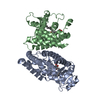 2zk3C 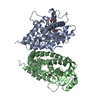 2zk4C 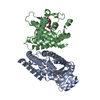 2zk5C 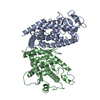 1prgS C: citing same article ( S: Starting model for refinement |
|---|---|
| Similar structure data |
- Links
Links
- Assembly
Assembly
| Deposited unit | 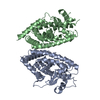
| ||||||||
|---|---|---|---|---|---|---|---|---|---|
| 1 |
| ||||||||
| 2 | 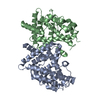
| ||||||||
| Unit cell |
|
- Components
Components
| #1: Protein | Mass: 32530.652 Da / Num. of mol.: 2 / Fragment: ligand binding domain Source method: isolated from a genetically manipulated source Source: (gene. exp.)  Homo sapiens (human) / Gene: PPARG / Plasmid: pET28a / Production host: Homo sapiens (human) / Gene: PPARG / Plasmid: pET28a / Production host:  #2: Water | ChemComp-HOH / | |
|---|
-Experimental details
-Experiment
| Experiment | Method:  X-RAY DIFFRACTION / Number of used crystals: 1 X-RAY DIFFRACTION / Number of used crystals: 1 |
|---|
- Sample preparation
Sample preparation
| Crystal | Density Matthews: 2.68 Å3/Da / Density % sol: 54.15 % |
|---|---|
| Crystal grow | Temperature: 293 K / Method: vapor diffusion, hanging drop / pH: 7.5 Details: 0.1M HEPES, 0.8M Sodium Citrate, pH 7.5, VAPOR DIFFUSION, HANGING DROP, temperature 293K |
-Data collection
| Diffraction | Mean temperature: 100 K |
|---|---|
| Diffraction source | Source:  SYNCHROTRON / Site: SYNCHROTRON / Site:  SPring-8 SPring-8  / Beamline: BL38B1 / Wavelength: 1 Å / Beamline: BL38B1 / Wavelength: 1 Å |
| Detector | Type: RIGAKU JUPITER 210 / Detector: CCD / Date: Nov 21, 2007 |
| Radiation | Monochromator: Fixed exit Si 111 double crystal monochromator Protocol: SINGLE WAVELENGTH / Monochromatic (M) / Laue (L): M / Scattering type: x-ray |
| Radiation wavelength | Wavelength: 1 Å / Relative weight: 1 |
| Reflection | Resolution: 2.36→50 Å / Num. all: 27662 / Num. obs: 26963 / % possible obs: 97.5 % / Observed criterion σ(I): 0 / Redundancy: 3.6 % / Biso Wilson estimate: 32.8 Å2 / Rmerge(I) obs: 0.064 / Net I/σ(I): 13.7 |
| Reflection shell | Resolution: 2.36→2.44 Å / Redundancy: 3.2 % / Rmerge(I) obs: 0.273 / Num. unique all: 2325 / % possible all: 84.9 |
- Processing
Processing
| Software |
| ||||||||||||||||||||||||||||||||||||||||||||||||||||||||||||||||||||||||||||||||
|---|---|---|---|---|---|---|---|---|---|---|---|---|---|---|---|---|---|---|---|---|---|---|---|---|---|---|---|---|---|---|---|---|---|---|---|---|---|---|---|---|---|---|---|---|---|---|---|---|---|---|---|---|---|---|---|---|---|---|---|---|---|---|---|---|---|---|---|---|---|---|---|---|---|---|---|---|---|---|---|---|---|
| Refinement | Method to determine structure:  MOLECULAR REPLACEMENT MOLECULAR REPLACEMENTStarting model: PDB ENTRY 1PRG Resolution: 2.36→32.77 Å / Rfactor Rfree error: 0.009 / Data cutoff high absF: 253643.77 / Data cutoff low absF: 0 / Isotropic thermal model: RESTRAINED / Cross valid method: THROUGHOUT / σ(F): 0 / Stereochemistry target values: Engh & Huber
| ||||||||||||||||||||||||||||||||||||||||||||||||||||||||||||||||||||||||||||||||
| Solvent computation | Solvent model: FLAT MODEL / Bsol: 38.2554 Å2 / ksol: 0.327853 e/Å3 | ||||||||||||||||||||||||||||||||||||||||||||||||||||||||||||||||||||||||||||||||
| Displacement parameters | Biso mean: 52.6 Å2
| ||||||||||||||||||||||||||||||||||||||||||||||||||||||||||||||||||||||||||||||||
| Refine analyze |
| ||||||||||||||||||||||||||||||||||||||||||||||||||||||||||||||||||||||||||||||||
| Refinement step | Cycle: LAST / Resolution: 2.36→32.77 Å
| ||||||||||||||||||||||||||||||||||||||||||||||||||||||||||||||||||||||||||||||||
| Refine LS restraints |
| ||||||||||||||||||||||||||||||||||||||||||||||||||||||||||||||||||||||||||||||||
| LS refinement shell | Resolution: 2.36→2.51 Å / Rfactor Rfree error: 0.027 / Total num. of bins used: 6
| ||||||||||||||||||||||||||||||||||||||||||||||||||||||||||||||||||||||||||||||||
| Xplor file |
|
 Movie
Movie Controller
Controller



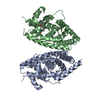

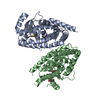
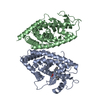


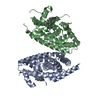
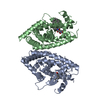

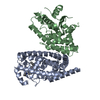
 PDBj
PDBj
